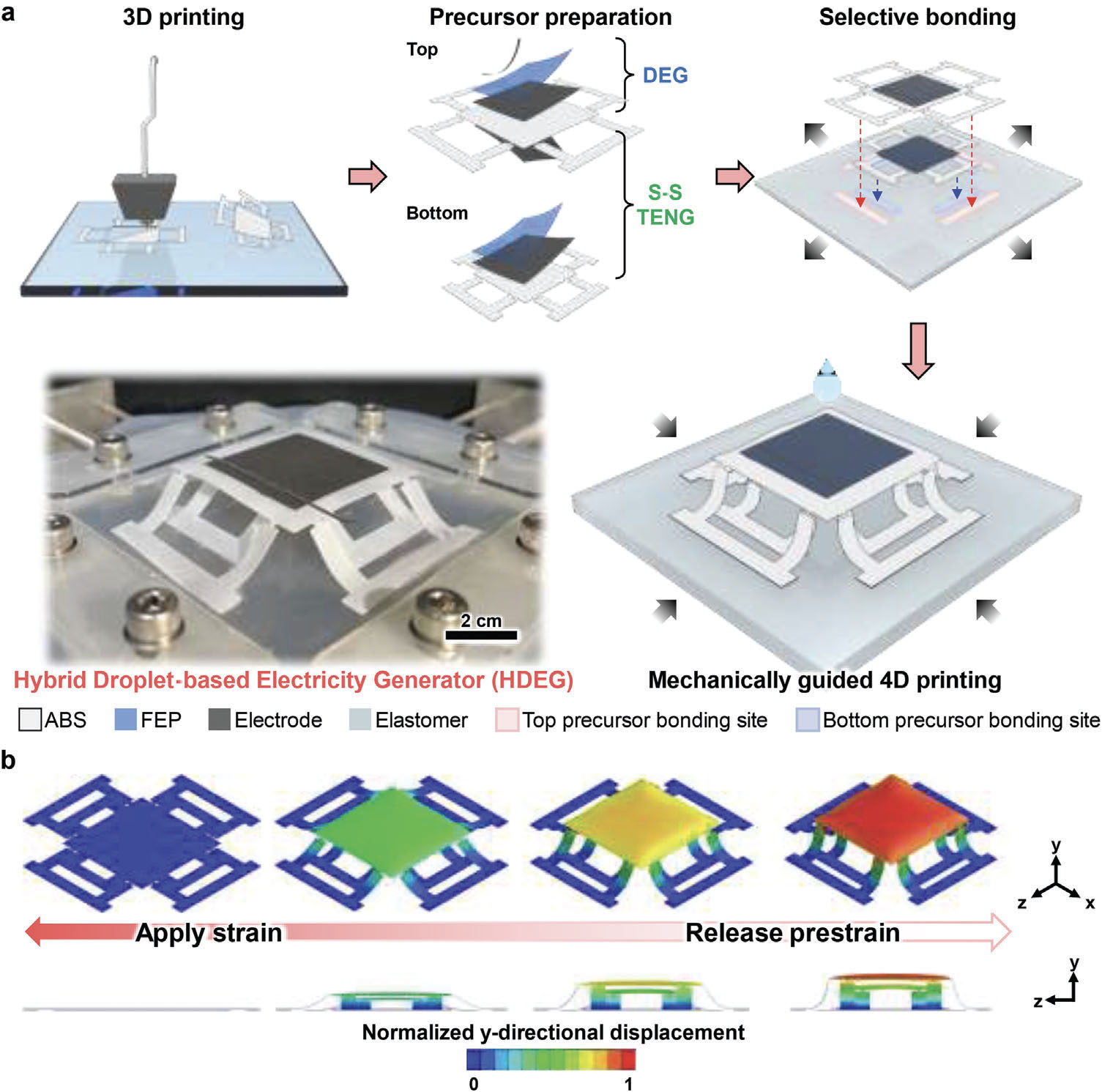| Oct 19, 2023 | |
New 4D-printed generator makes water droplets more powerful |
|
| (Nanowerk Spotlight) Water contains tremendous untapped energy, but very little of it is being harnessed currently. On a large scale, dams harvest hydroelectric power, while tidal and wave energy plants are emerging. On a smaller scale, researchers have developed devices that can generate electricity from water droplets. While less powerful individually, droplets are ubiquitous, making their potential highly promising. | |
| To further advance droplet energy harvesting, researchers from Kyung Hee University in South Korea have now created an “elastic hybrid droplet-based electricity generator” (HDEG) that captures kinetic energy from falling droplets more efficiently. | |
| They report their findings in Advanced Materials ("Advancing Energy Harvesting Efficiency from a Single Droplet: A Mechanically Guided 4D Printed Elastic Hybrid Droplet-Based Electricity Generator"). | |
| Previous efforts to harvest energy from droplets led to the development of droplet-based electricity generators (DEGs). DEGs work by generating triboelectric charges when droplets make contact with the generator's surface. The electrical energy comes from the kinetic energy of the falling droplets (read our comprehensive discussion on water droplet-based nanogenerators here). | |
| However, DEGs are not able to fully capture all of the droplets' kinetic energy, resulting in significant energy losses as some of the energy gets wasted. | |
| To address this limitation, the researchers in this new study developed an elastic hybrid droplet-based electricity generator (HDEG) that captures more of the kinetic energy. | |
| The HDEG merges a DEG with a solid-solid triboelectric nanogenerator (S-S TENG). Both technologies generate electricity through the triboelectric effect, taking advantage of the droplets' kinetic energy. | |
| The key innovation is the fabrication process based on 4D printing, an emerging technology that creates 3D printed objects that can reshape themselves over time. Unlike regular 3D printing, 4D printing incorporates special materials that respond to environmental stimuli like heat or moisture. | |
 |
|
| Schematic illustration and numerical simulation of mechanically guided 4D printing for manufacturing a HDEG. a)HDEG fabrication process via mechanical buckling-based 4D printing that involves 3D printing, precursor preparation, selective bonding, and mechanical buckling. The bottom left of the figure is an optical image of an HDEG configured with a DEG and an S–S TENG. b) FEA regarding the buckling phenomenon from the precursor to the pop-up-shaped structure and structural reversibility of the 4D printed elastic HDEG. (Reprinted with permission by Wiley-VCH Verlag) | |
| In this case, the researchers use a mechanically guided 4D printing technique. They first 3D print flat structures and attach the generator components. Then, by applying mechanical forces, they transform the flat structures into an elastic “pop-up” shape. | |
| This elastic design is crucial because it allows the otherwise wasted kinetic energy from the impacting droplets to be captured and converted into electricity by the S-S TENG. The DEG generates electricity from the surface energy as the droplets spread out, while the elastic TENG part uses the kinetic energy to deform and vibrate. | |
| Testing showed that the hybrid HDEG can generate around 30% more electricity than the DEG alone when activated by the same water droplets. This demonstrates the potential of hybridizing complementary triboelectric technologies. | |
| The researchers also systematically characterized how different structural parameters affect the electrical output. This provides design guidelines for further optimizing the HDEG’s performance. | |
| To demonstrate real-world applicability, the team showed that the HDEG can power small electronics like LED displays and sensors. A major advantage over solar and wind energy is the ubiquity of water droplets as a reliable energy source. | |
| While the generated power is still modest, this research highlights the promise of hybridizing complementary nanogenerators. More efficient droplet energy harvesting could greatly expand the possibilities for self-powered devices, particularly for weather and other environmental monitoring applications. | |
| With further development and scalability demonstrated, the HDEG concept could become a key building block for ubiquitous energy harvesting systems that capture the abundant but untapped energy around us. | |
 By
Michael
Berger
– Michael is author of three books by the Royal Society of Chemistry:
Nano-Society: Pushing the Boundaries of Technology,
Nanotechnology: The Future is Tiny, and
Nanoengineering: The Skills and Tools Making Technology Invisible
Copyright ©
Nanowerk LLC
By
Michael
Berger
– Michael is author of three books by the Royal Society of Chemistry:
Nano-Society: Pushing the Boundaries of Technology,
Nanotechnology: The Future is Tiny, and
Nanoengineering: The Skills and Tools Making Technology Invisible
Copyright ©
Nanowerk LLC
|
|
|
Become a Spotlight guest author! Join our large and growing group of guest contributors. Have you just published a scientific paper or have other exciting developments to share with the nanotechnology community? Here is how to publish on nanowerk.com. |
|
